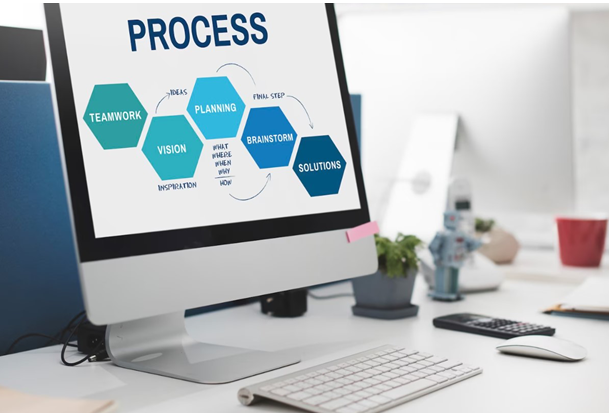Software engineering is a long journey from a single idea on paper all the way to a completed functional product coming to the hands of end-users. In such a long venture, a software application must travel through a number of stages, pass multiple quality gates, and undergo various tests to make itself verified as finalized. Even though these called development stages are almost fixed, they can vary project by project based on the nature of the final expectation of a software product. Therefore, project managers and their teams need to map out the right route to complete their software journey successfully.
Definition of SDLC
Software development process, or entirely software development lifecycle (SDLC), is an essential part of software engineering and also a term referring to the process of ideation, analysis, design, development, and testing of a software application in an iterative fashion from start to finish. It is a structure that should be followed to ensure the development process goes as smoothly as possible and to guarantee that all the elements of the software are functioning correctly according to expectations.
By following the SDLC process, developers can produce a product with more flexibility and reliability since they tend to focus and plan for potential problems before they arise during the development process. The process also allows developers to test and modify any product features that don’t meet expectations or requirements during the testing phase.
SDLC is used in almost all categories of software projects, from large-scale enterprise applications to small personal websites. It provides a framework that enables software engineers to approach the development process systematically and efficiently. When a project is delegated to a service vendor or conducted by dedicated team services, a product still has to venture through all the identical stages of SDLC as it is supposed to be done in-house.
Seven Core Stages of a Typical Software Development Process
A complete cycle of software development will consist of multiple basic, important steps that developers must abide by in order to produce a high-quality product. The following seven stages are the most common steps found in SDLC:
Planning (Requirement gathering)
The planning stage is the most important part of the software development process. This is where initial goals and objectives are established, resources are allocated, risk management strategies are outlined, and the overall timeline and scope of the project are outlined. The goal of this stage is to map out a plan that will serve as a blueprint for all the following stages in the SDLC.
Analysis (Requirement analysis and design)
The second stage of the SDLC is Analysis. This involves a thorough examination of the software requirements provided by the customer, identification of risks associated with meeting those requirements, and detailed design of system components to meet those needs. The output of this stage should be a detailed document that outlines how the project should be developed and tested.
Design (Architecture design)
This stage is about designing the architecture of the software solution, including the components that will make up the system, as well as how these components will interact with each other. This ensures that all components fit together logically, allowing for efficient development and testing in later stages. This stage also focuses on designing the user interface, which should meet the customer’s needs and be easy to use.
Development (Coding)
In this stage, developers will actually begin coding according to the design specifications created in earlier stages. This is where all of the features and functionality that were outlined in the planning and analysis stages are finally implemented into the software. Developers should also test their code to ensure that it meets the design specifications and customer requirements.
Testing (System, Integration, and User Acceptance Testing)
This phase is focused on testing the functionality of the software to make sure it works as designed. This includes system testing, integration testing, and user acceptance testing. System testing verifies that all components of the system work together correctly. Integration testing verifies that the system as a whole works together correctly, and user acceptance testing verifies that the software meets customer expectations.
Deployment (Product release)
As all tests have been passed, the software is ready to be deployed into production. This involves preparing the environment for the software, deploying the software, and monitoring it in production. This is also a good time to perform any additional maintenance or support tasks that may be necessary.
Maintenance (Bug fixing and updating)
This final phase of the SDLC involves providing ongoing support for the software product, such as bug fixes, feature updates/improvements, performance improvements, security updates, and more. This stage is ongoing and should be repeated as often as necessary in order to maintain the quality of the software product.

Strategies for Enhancing Your Software Development Cycle
Software development lifecycle can be enhanced in several ways, from process improvements to technology integration. Some strategies for improving your software development cycle that you can consider follow include:
- Utilizing agile and iterative methods such as Scrum or Kanban to improve the speed of delivery;
- Automating processes with tools like Jenkins or TeamCity;
- Introducing quality assurance processes to ensure that bugs and defects are caught before they reach production;
- Adopting a DevOps approach to streamline the transition from development to operations;
- Leveraging cloud technologies to enable faster deployment of applications.
By utilizing these strategies, organizations can improve their SDLC and ensure that software products are delivered at higher quality, faster speed, and at lower cost compared to traditional software development approaches. Additionally, these strategies can help teams achieve higher levels of productivity as well as better customer satisfaction.
Having a successful SDLC process is critical for companies looking to build quality software products that meet customer expectations and business objectives. By following the steps outlined in this article, organizations can ensure that their SDLC is completed and that they are producing high-quality software on time and within budget.







